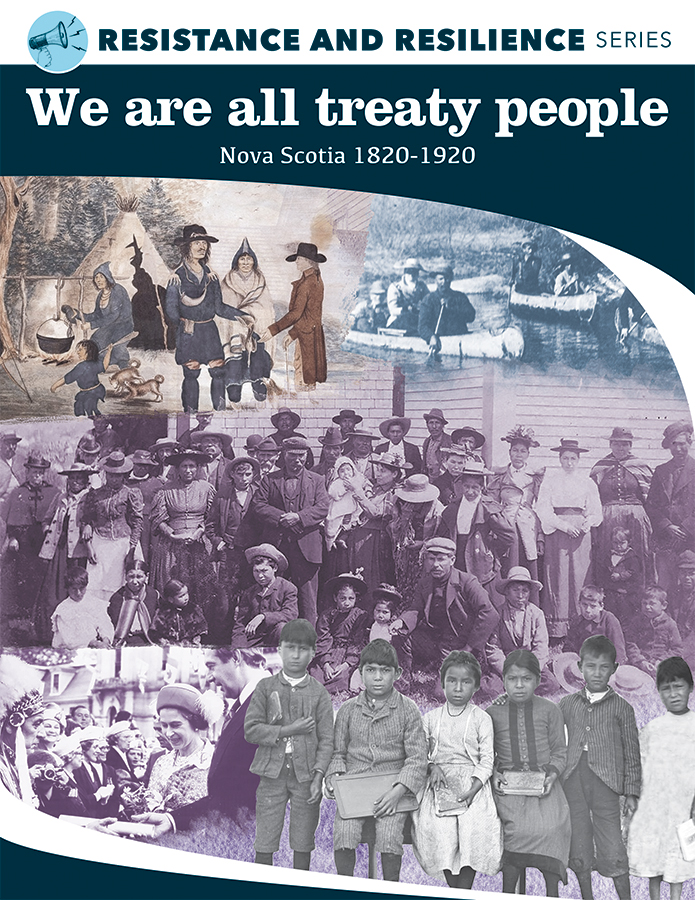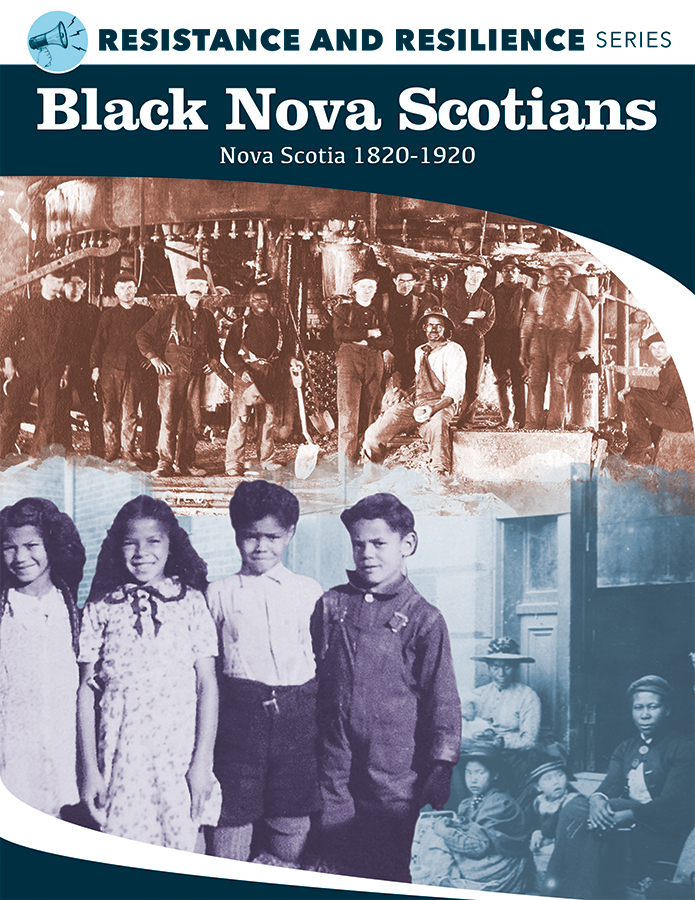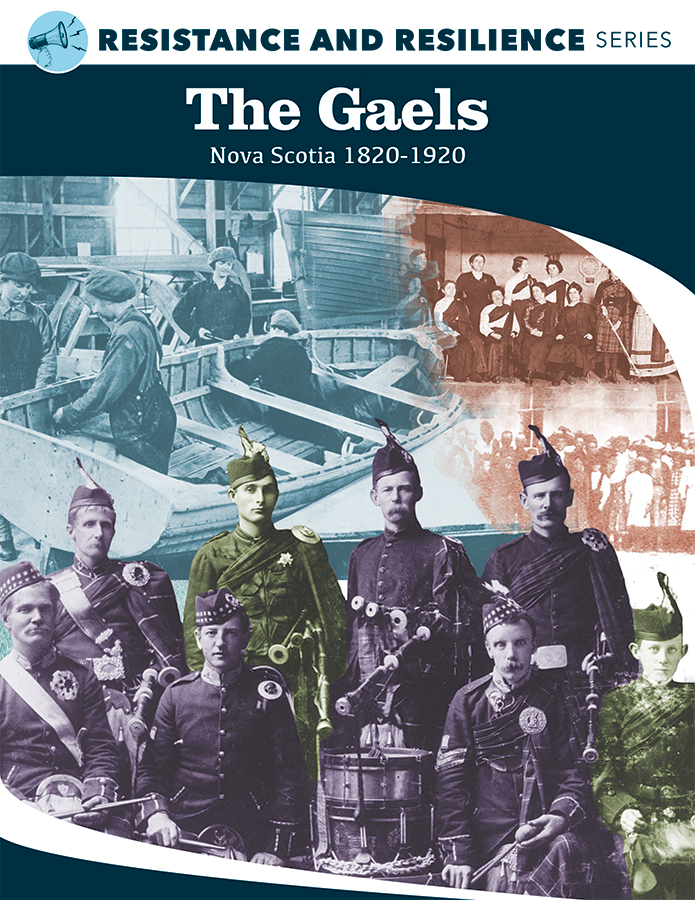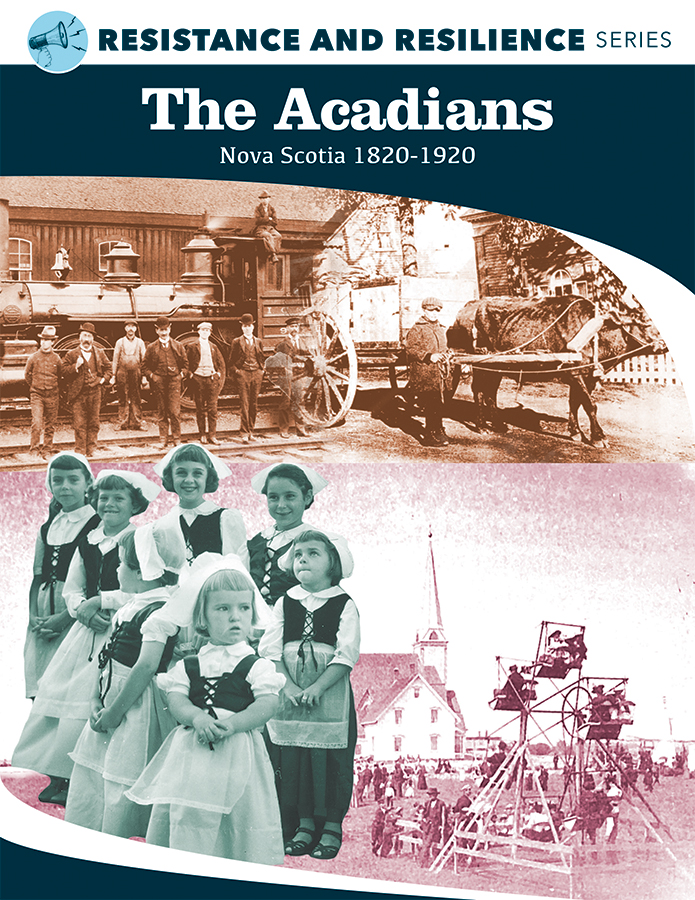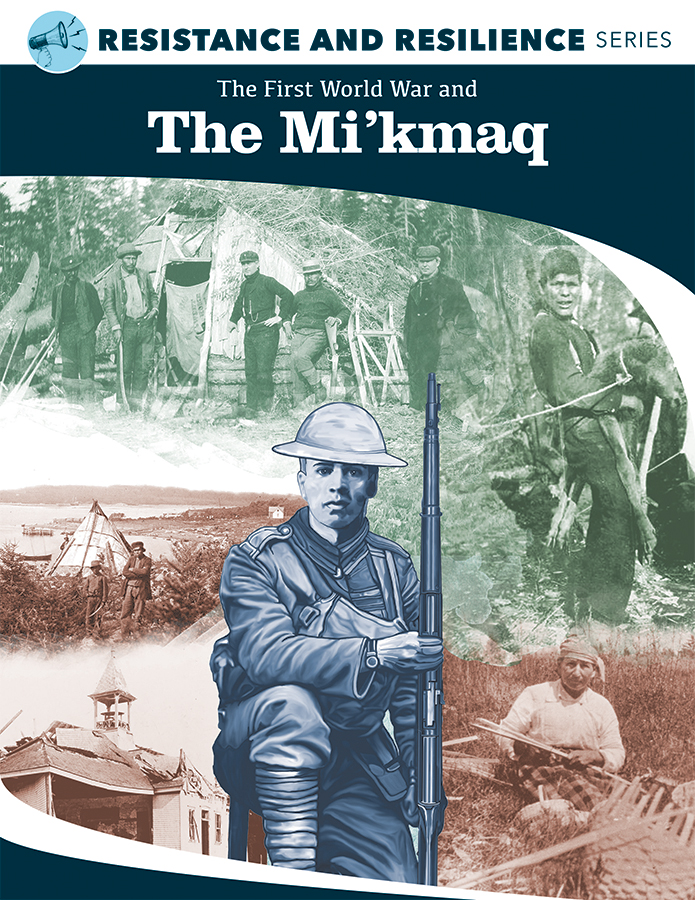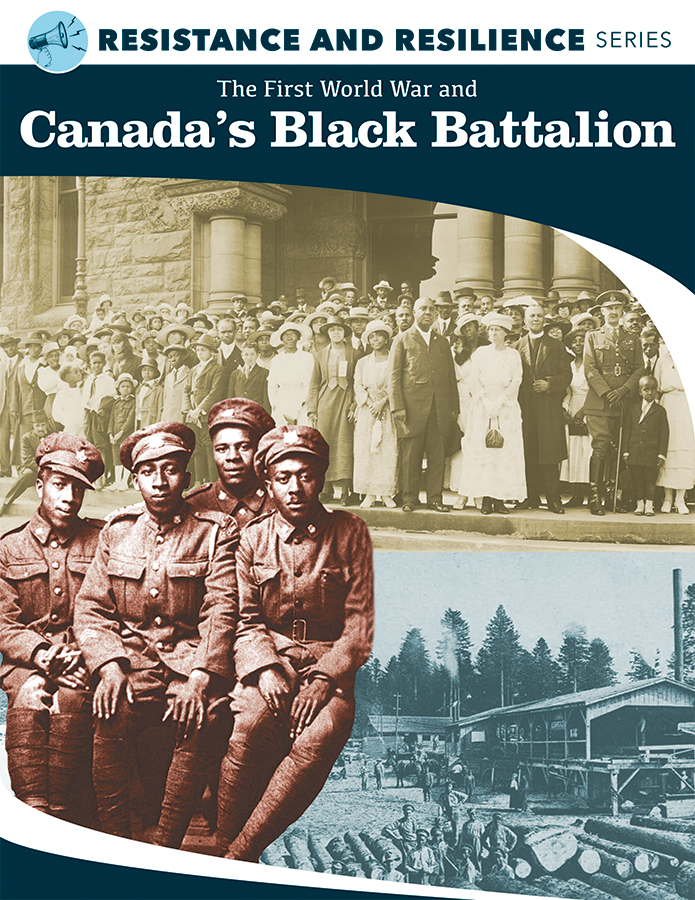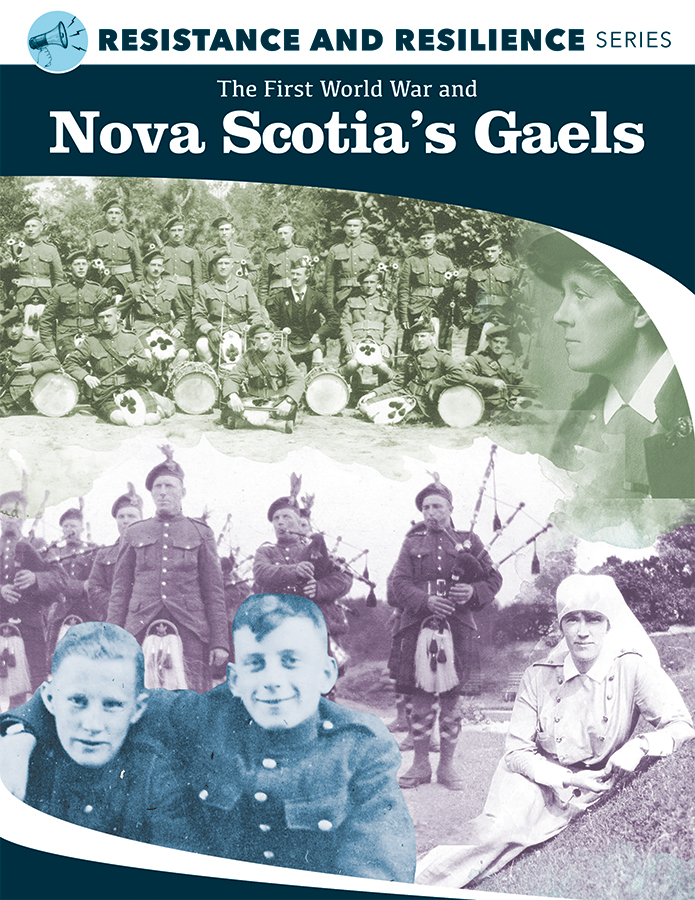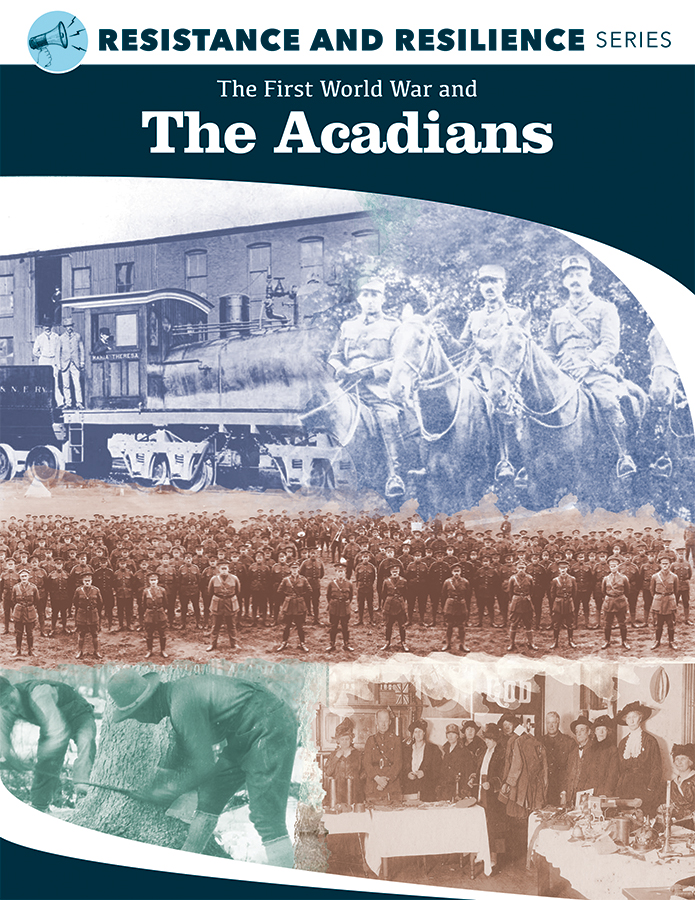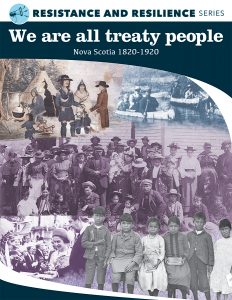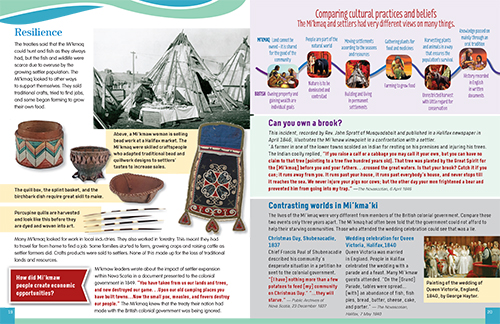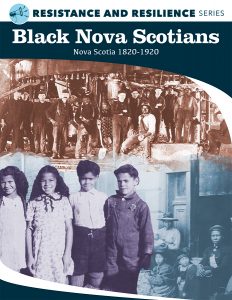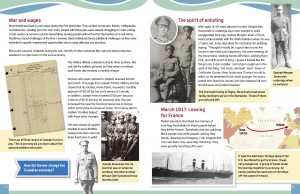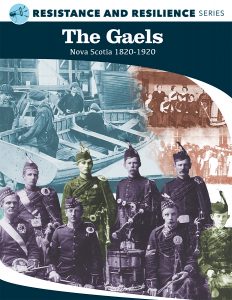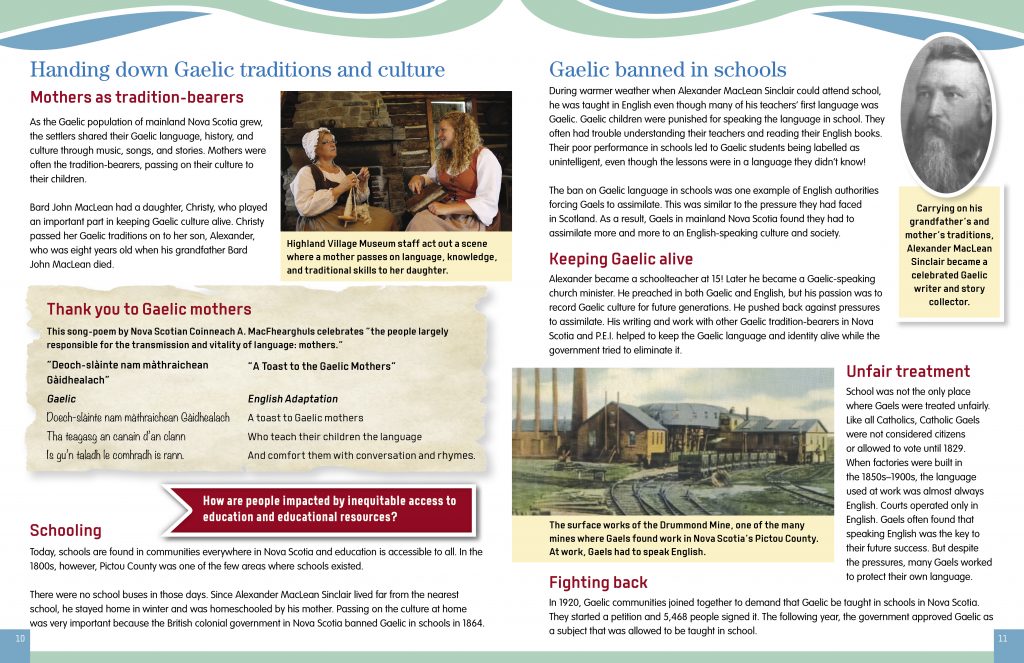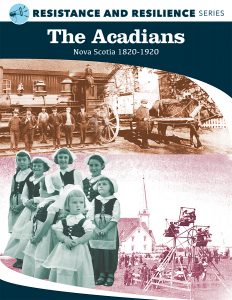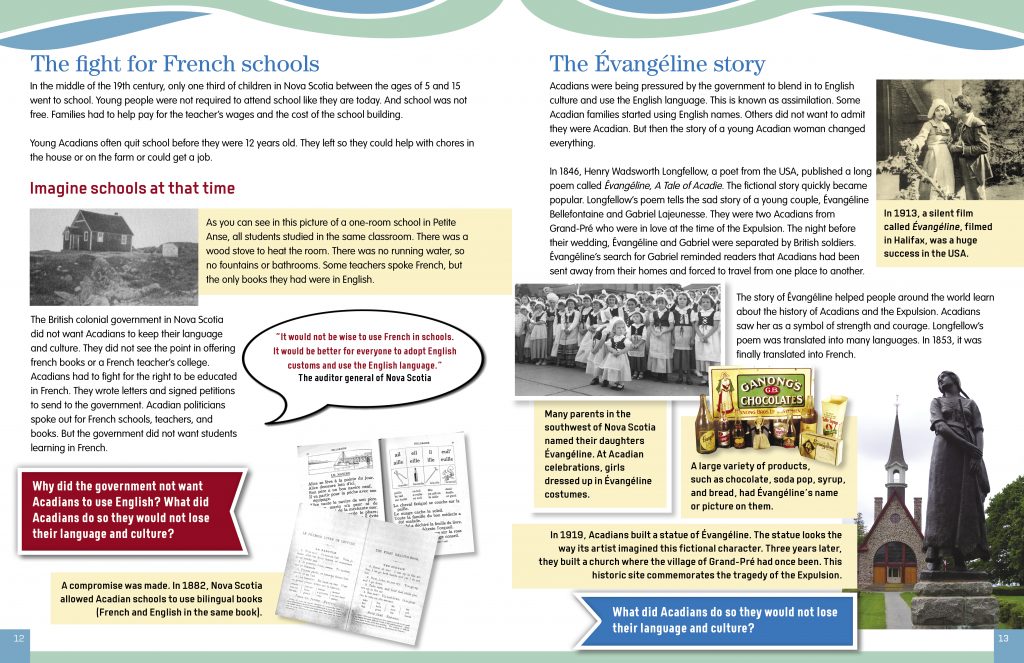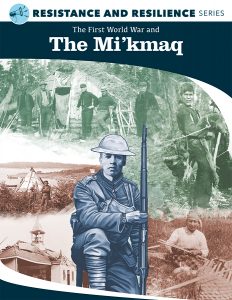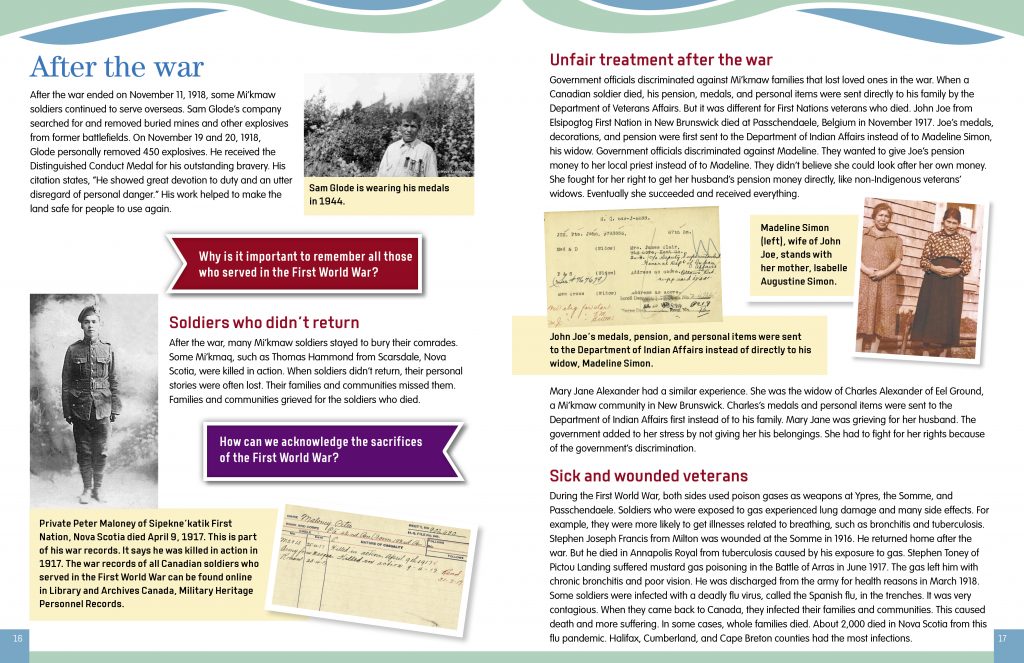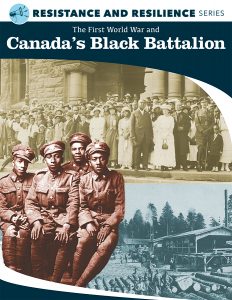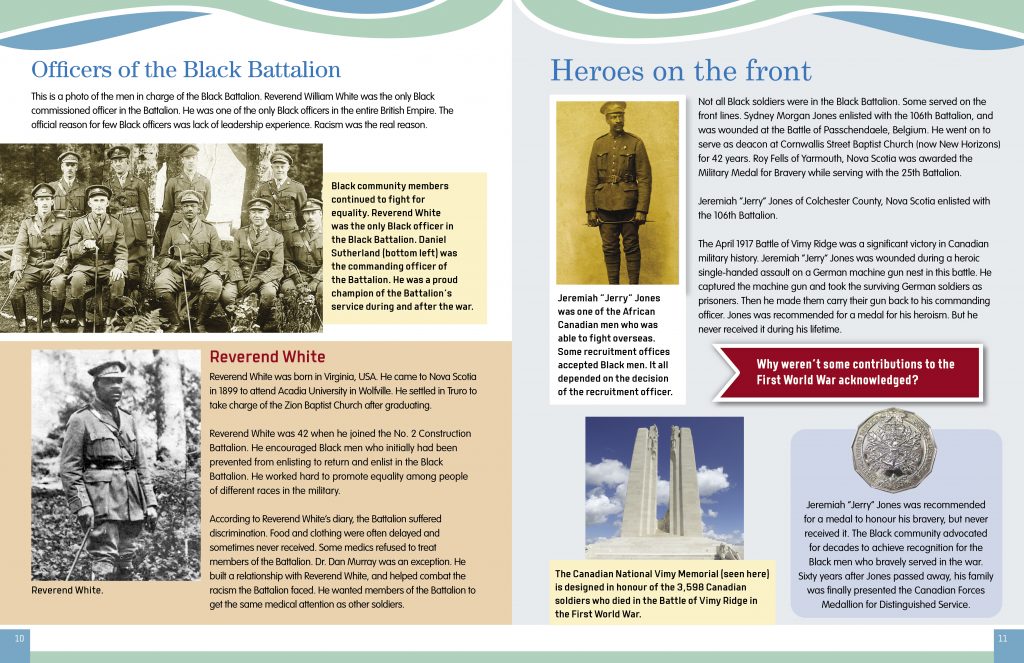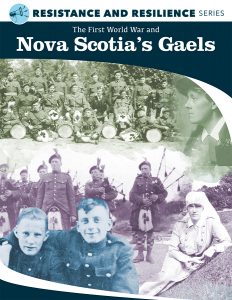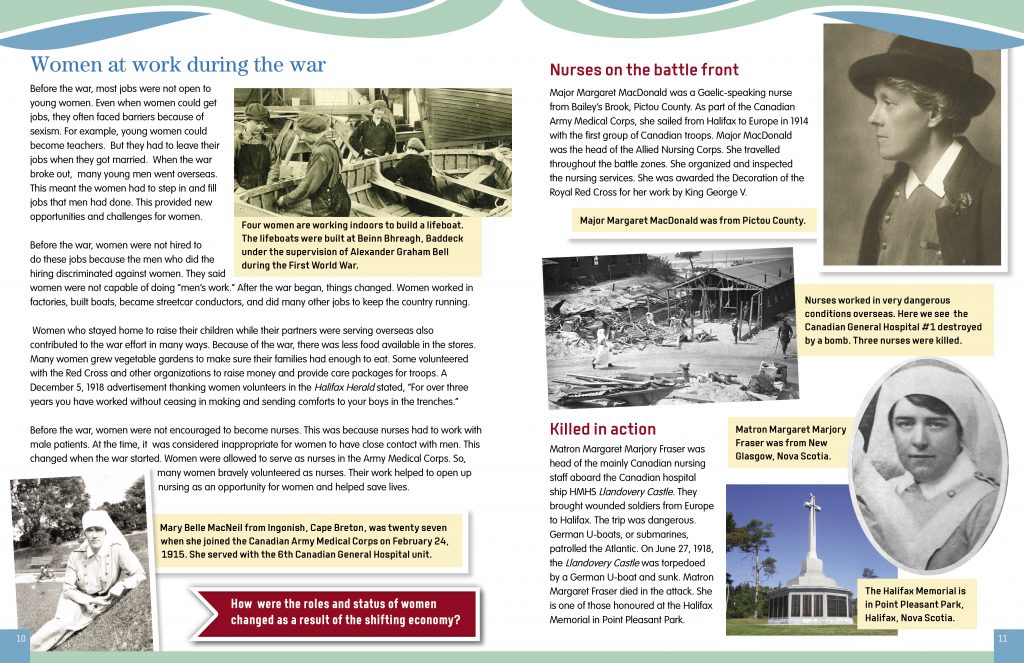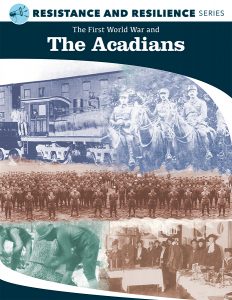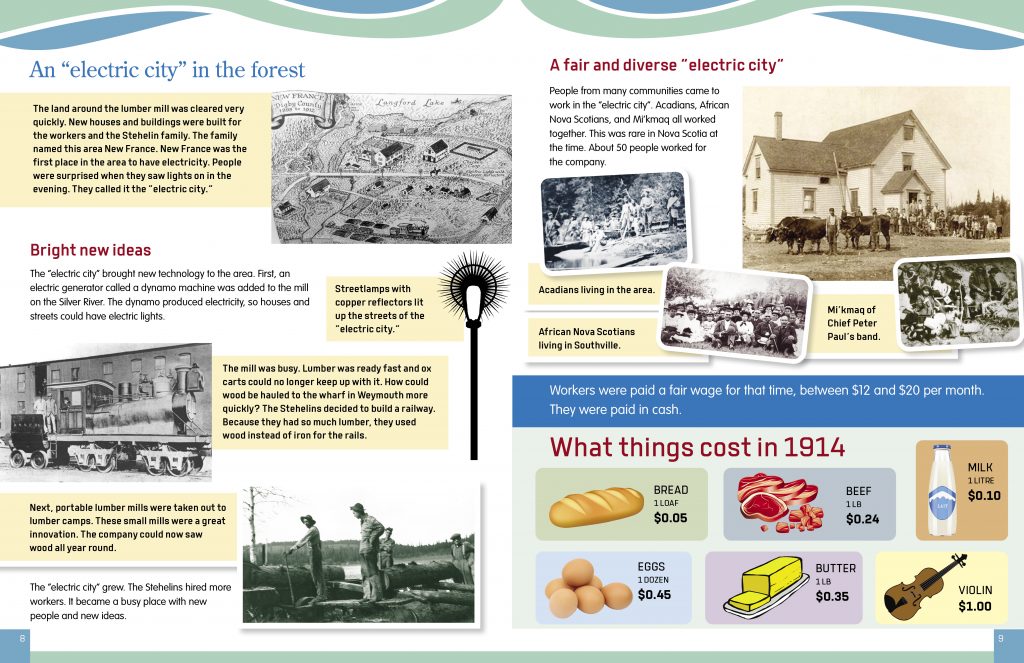8-volume English Set
Series Editors: Renee J. Bourgeois, Pamela Hickman and Heather M. Epp
Set: 8 volumes, 100+ b&w and colour illustrations in each volume | Page Extent: 16–37 pages Dimensions: 8.5″ x 11″
Binding: Saddle Stitched | ISBN: 978-1-990273-01-8 | Price: $189.00 (net)
Nova Scotia School Book Bureau #2002661
In the Resistance and Resilience series readers will learn about the cultural perseverance of Black Nova Scotians, the Mi’kmaq, Acadians, and the Gaels to 1920. The eight-booklet set covers more than a century of nation-building that saw many discriminatory and racist policies enacted by governments.
Four booklets focus on the 1820–1920 period, and describe the resistance and achievement of each group to the systemic oppression, racism and sexism they experienced. The social, cultural and economic experiences of people from these communities is documented.
Four booklets explore the experiences of each of the four groups during the First World War. Readers will learn about the recruitment and deployment of segregated fighting units including the 165th Acadian Battalion, the Gaelic 185th Cape Breton Highlanders, and the all-Black No. 2 Construction Battalion. The experiences of Mi’kmaw soldiers who voluntarily enlisted are described in the fourth booklet.
A kit of eight artefacts and a resource guide book complementing the series is also available. The artefacts connect to the historical experiences of the Mi’kmaq, Acadians, Black Nova Scotians and the Gaels during the 1820-1920 period.
The booklet set is also available in French.
Series Titles
NEW AND DIVERSE PERSPECTIVES ON 19th CENTURY NOVA SCOTIA HISTORY
We are all treaty people: Nova Scotia 1820-1920
How treaties with the Mi’kmaq were violated by governments in order to push the Mi’kmaq to the edges of Nova Scotia society.
The Mi’kmaq were deprived of land, food and shelter, while their language and culture were attacked. This volume includes the story of their resistance and resilience.
This volume covers the interaction between the Mi’kmaq and settlers from the signing of treaties until 1920. The focus is on 1820-1920. Expectations around land and resources are described along with resulting conflicts. How governments and settlers acted to deprive the Mi’kmaq of traditional lands, food and shelter as well as the efforts of the Mi’kmaq to resist and advocate for autonomy are documented.
This volume covers the effort to eliminate Mi’kmaw language and culture, and Mi’kmaw activity that clearly rejected assimilation. A little-known Mi’kmaw initiative to negotiate with British authorities for treaty protection during Confederation is described. Post-Confederation government policies (including the continuation of the reserve system) and actions in violation of the commitments made under the Peace and Friendship treaties are highlighted.
This volumes describes how today we are still all are treaty people.
37 pages
100+ b&w and colour illustrations
Included in 8-volume set ISBN 978-1-990273-01-8
Black Nova Scotians: Nova Scotia 1820-1920
How Nova Scotia’s Black community has organized and resisted across generations of racism and discrimination from governments and society.
Black Nova Scotians have always resisted, demanding equality and educational opportunity since arriving here. This volume highlights how strong communities have persisted, with churches as a key centre for family and social life.
People of African descent settled in Nova Scotia in the 1700s; some were enslaved and many were free. African Nova Scotians established numerous small communities throughout Nova Scotia, but were not safe from institutional racism and discrimination. Many types of work were closed to them. Despite this, the community found ways to survive and thrive: community pressure on government led to free schooling – though the schools were segregated with fewer resources. Immigration added to and strengthened the population – but racism was rampant, causing some skilled immigrant workers turned their back on Nova Scotia. The necessary resilience of this founding cultural group is discussed in this volume.
20 pages
100+ b&w and colour illustrations
Included in 8-volume set ISBN 978-1-990273-01-8
The Gaels: Nova Scotia 1820-1920
How Gaelic-speaking immigrants resisted discrimination and pressure to assimilate to English culture
The Gaels in Nova Scotia during the 1820–1920 period were targeted by government measures and community pressure to abandon their language and culture. This volume describes the widespread resistance to discrimination and prejudice, and how the Gaels were successful in retaining a measure of their lifestyle and identity.
Beginning in the late 1700s, Gaelic-speaking Scottish immigrants arrived and settled in mainland Nova Scotia and on Cape Breton Island. They lived as farmers and fishers, often in remote areas with poor land that made survival difficult. Gaels faced discrimination because of their language and culture, and Nova Scotia’s colonial government worked to force them to give it up and adopt English custom and language. Communities were resilient and resisted these pressures in order to retain their identity as Gaels. This volume describes that though assimilation was ascendant in this period, the Gaelic community found ways to survive.
20 pages
100+ b&w and colour illustrations
Included in 8-volume set ISBN 978-1-990273-01-8
The Acadians: Nova Scotia 1820-1920
How Acadians revived and rebuilt their community after being violently expelled by the colonial British government
After British officials followed an inhuman scorched-earth policy in 1755 to force Acadians out of Nova Scotia, those who returned were pushed far from their previously prosperous farmland. This volume describes how the Acadians worked to regain a measure of prosperity and built organizations that protected their language and promoted their interests. By 1920 the Acadian community in Nova Scotia was re-established, but they were still fighting for their rights as a culture.
Acadians were the first Europeans to settle in Nova Scotia, but British colonial officials thought the Acadians’ French language and Catholic religion made them enemies. The British forced the Acadians out of Nova Scotia with a scorched-earth campaign of ethnic cleansing in 1755.
After 1768, Acadian people could return to Nova Scotia, but not to the land they had owned and farmed for the 150 years prior. Instead, they were given land of poor quality in remote locations. From this position, Acadians had to restart their lives and rebuild their communities, working to assert their autonomy with strong leaders and organizations advocating for language and cultural rights. This advocacy led to French being allowed in schools, French teachers being trained, newspapers founded, and political rights gained. This volume explains how Acadians used innovative structures like national conventions and co-operatives to develop their own businesses and economic life.
24 pages
100+ b&w and colour illustrations
Included in 8-volume set ISBN 978-1-990273-01-8
NEW AND DIVERSE PERSPECTIVES ON THE FIRST WORLD WAR FOR NOVA SCOTIANS
The First World War and the Mi’kmaq
How Mi’kmaw soldiers volunteered during the First World War, and how they advocated for inclusion in Canada’s collective post-war remembrance against systemic barriers upheld by racist policies
When the British government enlisted Canada to join the First World War in Europe, many Mi’kmaq chose to sign up only to have Canadian military authorities reject them. Later in the war, the military changed its policies because they needed more recruits and again several hundred Mi’kmaq volunteered. This booklet describes the experiences of Mi’kmaw soldiers in Europe and of Mi’kmaw families in Canada during the war, with the devastating impact of the Halifax Explosion on the Mi’kmaw community of Turtle Grove described. Also explored is the systemic racism in Canada that pre-empted the many unfair ways in which Mi’kmaw veterans and their families were treated after the war. But the veterans and their families continued to demand equal treatment and full recognition for their contribution to the Canadian war effort, recognition that has come in recent years.
20 pages
100+ b&w and colour illustrations
Included in 8-volume set ISBN 978-1-990273-01-8
The First World War and Canada’s Black Battalion
How Black Nova Scotians successfully campaigned for the right to serve in the First World War, and their experiences in the Canadian Forestry Corps
When the British government enlisted Canada in fighting the First World War in Europe many African Nova Scotians tried to enlist. Most were rejected because of the prejudice and racist ideas openly expressed by military authorities. The Black community campaigned and petitioned for the right to serve and in 1916, the military relented and created a segregated Black Battalion, the #2 Construction Battalion, based in Nova Scotia. Black men were recruited, but were restricted to non-combat service in Europe. Many served in the Canadian Forestry Corps. This volume describes the experiences of some of the Black soldiers as they were recruited, served in Europe and returned to Canada. After pressure from the Black community, the role of the #2 Construction Battalion has recently been recognized.
17 pages
100+ b&w and colour illustrations
Included in 8-volume set ISBN 978-1-990273-01-8
The First World War and Nova Scotia’s Gaels
How Nova Scotia’s Gaels formed a volunteer battalion to serve in the First World War and were forced to disband to further the British project of assimilation
During the First World War, a recently-abandoned mining town was taken over by the Canadian military and used to house the recruits of a new battalion, the 185th Cape Breton Highlanders. Volunteers for this Gaelic battalion – most of whom where Gaelic speakers from isolated rural communities – were attracted by a promise that they would serve together in Europe. But when they landed overseas, British commanders broke up the battalion. This volume describes how the war was reflected in Gaelic poetry, songs and letters. The experiences of women, in Nova Scotia and in Europe, are also described. Wounded and returning veterans brought the 1918-19 Spanish flu pandemic to remote corners of rural Cape Breton, contributing to its devastating impact on the province and the country. The war’s overall impact was to increase the pressures on the Gaelic community towards assimilation into the English majority in Nova Scotia.
17 pages
100+ b&w and colour illustrations
Included in 8-volume set ISBN 978-1-990273-01-8
The First World War and the Acadians
How the Acadian community responded to the First World War and how an innovative Acadian lumber mill built an “electric city”
This volume offers an new perspective on Nova Scotia’s experience of the First World War.
The Acadian communities of south-west Nova Scotia had seen new energy in the 1890s in the form of an investor coming from France who built an innovative lumber mill business near Weymouth, Nova Scotia. He made the first use of electricity in the area, and his mill community was quickly named “electric city.” The mill offered good jobs to many men of diverse backgrounds. When war broke out five of his adult sons were required by French law to return to France and fight.
A sixth son was recruited by the Canadian army in 1916 to train Acadians who signed up to go to war with a new French-language Acadian battalion. Once in Europe, most of the recruits were assigned not to fighting units but to the same forestry work they had done in Canada.
In 1917, the Canadian government forced all eligible men to join the armed forces. This decision was intensely controversial in Canada. It divided the Acadian community as well.
During the war, the lumber mill was busy and successful. But by 1923 the business was going downhill and the investor’s family decided to sell their mill. The mill and surrounding buildings were ultimately abandoned.
The intertwined story of this innovative lumber mill, its owners, the “electric city” community they built around the mill and Acadian participation in the First World War has been recorded and told in several books and plays.
20 pages
100+ b&w and colour illustrations
Included in 8-volume set ISBN 978-1-990273-01-8

